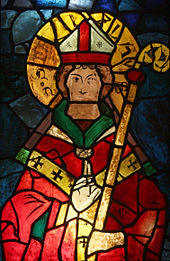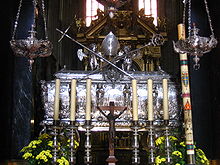Stanislaus of Szczepanów
This article needs additional citations for verification. (October 2021) |
Traditional Roman Catholics) 8 May (in Poland) | |
|---|---|
| Attributes | Episcopal insignia, sword, resurrected Piotr |
| Patronage | Poland, Kraków, moral order |
Stanislaus of Szczepanów (Polish: Stanisław ze Szczepanowa; 26 July 1030 – 11 April 1079) was a Polish Catholic prelate who served as Bishop of Kraków and was martyred by the Polish King Bolesław II the Bold. Stanislaus is venerated in the Catholic Church as Stanislaus the Martyr (as distinct from the 16th-century Jesuit, Stanislaus Kostka).
Life
According to
After the bishop's death (1072), Stanislaus was elected his successor[2] but accepted the office only at the explicit command of Pope Alexander II. Stanislaus was one of the earliest native Polish bishops. He also became a ducal advisor and had some influence on Polish politics.
Stanislaus' major accomplishments included bringing
Legend

Stanislaus initial conflict with King Bolesław was over a land dispute. Stanislaus had purchased for the diocese a piece of land on the banks of the Vistula River near Lublin from a certain Peter (Piotr), but after Piotr's death the land had been claimed by his family. The King ruled for the claimants, but according to legend, Stanislaus resurrected Piotr so that he could confirm that he had sold the land to the bishop.
According to
Piotr was then dressed in a cloak and brought before King Bolesław to testify on Stanislaus' behalf. The dumbfounded court heard Piotr reprimand his three sons and testify that Stanislaus had indeed paid for the land. Unable to give any other verdict, the King dismissed the suit against the bishop. Stanislaus asked Piotr whether he would remain alive, but Piotr declined and so was laid to rest once more in his grave and was reburied.
Chastisement of Bolesław

A more substantial conflict with King Bolesław arose after a prolonged war in Ruthenia, when weary warriors deserted and went home, alarmed at tidings that their overseers were taking over their estates and wives. According to Wincenty Kadłubek, the King punished the soldiers' faithless wives very cruelly and was criticized for it by Bishop Stanislaus. Jan Długosz, however, writes that the bishop had in fact criticized the King for his own sexual immorality. Gallus Anonymus, in his laconic account, only condemned both the "traitor bishop" and the violent king.
Whatever the actual cause of the conflict between them, the result was that the bishop
Martyrdom

King Bolesław sent his men to execute Bishop Stanislaus but when they didn't dare to touch the bishop, the King decided to kill the bishop himself.[4] He is said to have slain Stanislaus while he was celebrating Mass in the Skałka outside the walls of Kraków.[2] According to Paweł Jasienica: Polska Piastów, it was actually in the Wawel Castle. The guards then cut the bishop's body into pieces and scattered them to be devoured by wild beasts.[2] According to the legend, his members miraculously reintegrated while the pool was guarded by four eagles.
The exact date of Stanislaus's death is uncertain. According to different sources, it was either 11 April or 8 May 1079.
The murder stirred outrage throughout the land and led to the dethronement of King
Whether Stanislaus should be regarded as a traitor or a hero remains one of the classic unresolved questions of Polish history. His story has a parallel in the murder of Thomas Becket in 1170 by henchmen of England's King Henry II.
Original sources
There is little information about Stanislaus's life. The only near-contemporary source was a chronicle of Gallus Anonymus, but the author evaded writing details about a conflict with the king. Later sources are the chronicles of Wincenty Kadłubek, and two hagiographies by Wincenty of Kielcza. All contain hagiographic matter.
Veneration as a saint
The cult of Saint Stanislaus the Martyr began immediately upon his death. In 1245 his relics were translated (i.e., moved) to Kraków's Wawel Cathedral. In the early 13th century, Bishop Iwo Odrowąż initiated preparations for Stanislaus' canonization and ordered Wincenty of Kielce to write the martyr's vita. Stanislaus of Kraków was canonized by Pope Innocent IV at Assisi in 1253.[5]

As the first native Polish saint, Stanislaus is the patron of Poland and Kraków,
Saint Stanislaus' veneration has had great patriotic importance. In the period of Poland's feudal fragmentation, it was believed that Poland would one day reintegrate as had the members of his body. Half a millennium after Poland had indeed reintegrated, while yet another dismemberment of the polity was underway in the Partitions of the Polish–Lithuanian Commonwealth, the framers of the Polish Constitution of 3 May 1791, would dedicate this progressive political document to Saint Stanislaus, whose feast day fell close to the date of the Constitution's adoption.
Each year on the first Sunday after 8 May, a procession, led by the Bishop of Kraków, goes out from
Roman Catholic churches belonging to Polish communities outside Poland are often dedicated to Saint Stanislaus.
In iconography, Saint Stanislaus is usually depicted as a bishop holding a sword, the instrument of his martyrdom, and sometimes with Piotr rising from the dead at his feet.
Feast Day
- 25 January – commemoration of translation of relics to Church of Saint Roch,[8]
- 11 April – commemoration of death anniversary,[9]
- 7 May – commemoration by (Traditional Roman Catholics),[10]
- 8 May – main commemoration in Poland,[11]
- 27 September – commemoration of translation of relics from Skałka to Wawel,[12][13]
- 6 October – commemoration of translation of relics to Esztergom,[8]
See also
- Gaude Mater Polonia
- Archbishop of Kraków
- Order of Saint Stanislaus
- Saint Stanislaus of Szczepanów, patron saint archive
Further reading
- Dlugosh, Joannes (1711). Cracoviensis historiae Polonicae libri XII (in Latin). Vol. I. Leipzig: sumptibus Ioannis Ludovici Gleditschii. pp. 269–295.
- Bałukówna, Teresa J., and Tadeusz Ulewicz. "ST. STANISLAUS OF SZCZEPANÓW IN OLD POLISH LITERATURE AND CULTURE." Aevum, vol. 54, no. 2, Vita e Pensiero – Pubblicazioni dell’Università Cattolica del Sacro Cuore, 1980, pp. 287–314
References
- ^ a b c Britannica, The Editors of Encyclopaedia. "Saint Stanislaus of Kraków". Encyclopedia Britannica
- ^ ISBN 971-91595-4-5.
- ^ Herbermann, Charles, ed. (1913). . Catholic Encyclopedia. New York: Robert Appleton Company.
- ^ a b Saint Stanislaus, Franciscan Media, April 11, 2021
- ^ "Saint Stanislaus of Krakow", Aleteia
- ^ Calendarium Romanum (Libreria Editrice Vaticana, 1969), p. 122
- ^ "Saint Stanislaus", Living Space, the Irish Jesuits
- ^ a b "Stanislaus von Krakau – Ökumenisches Heiligenlexikon". www.heiligenlexikon.de (in German). Retrieved 19 August 2022.
- ^ Catholic Church (2004). Martyrologium Romanum (2004).
- ^ "Saint Stanislaus, Bishop of Cracow, Martyr". sanctoral.com. Retrieved 19 August 2022.
- ^ "8 maja: św. Stanisława, biskupa i męczennika, głównego patrona Polski". ordo.pallotyni.pl. Retrieved 19 August 2022.
- ^ Manikowska, Halina. "Przeszłość pod ochroną: relikwie" (PDF).
- ^ "Kult św. Stanisława w Piotrawinie". www.wilanow-palac.pl. Retrieved 19 August 2022.

